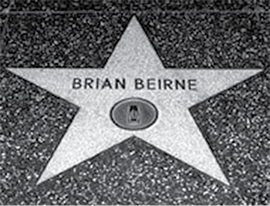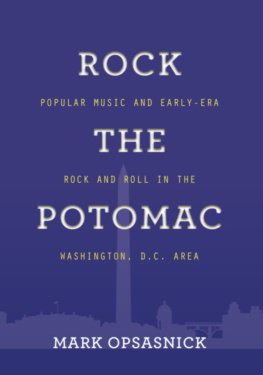J.C. DE LADURANTEY
THE DOCTOR OF DOO-WOP
Making Your
Memories
with
Rock
& Roll
and
Doo-Wop
THE MUSIC AND ARTISTS OF
THE 1950s AND EARLY 1960s

MAKING YOUR MEMORIES WITH ROCK & ROLL AND DOO-WOP
THE MUSIC AND ARTISTS OF THE 1950S AND EARLY 1960S
Copyright 2016 J.C. De Ladurantey The Doctor of Doo-Wop.
All rights reserved. No part of this book may be used or reproduced by any means, graphic, electronic, or mechanical, including photocopying, recording, taping or by any information storage retrieval system without the written permission of the author except in the case of brief quotations embodied in critical articles and reviews.
iUniverse
1663 Liberty Drive
Bloomington, IN 47403
www.iuniverse.com
1-800-Authors (1-800-288-4677)
Because of the dynamic nature of the Internet, any web addresses or links contained in this book may have changed since publication and may no longer be valid. The views expressed in this work are solely those of the author and do not necessarily reflect the views of the publisher, and the publisher hereby disclaims any responsibility for them.
Any people depicted in stock imagery provided by Thinkstock are models,
and such images are being used for illustrative purposes only.
Certain stock imagery Thinkstock.
ISBN: 978-1-4917-8402-0 (sc)
ISBN: 978-1-4917-8401-3 (e)
Library of Congress Control Number: 2016900475
iUniverse rev. date: 02/17/2016
Contents
Mr. Brian Beirne has been one of the most familiar voices on the airwaves and is considered to be one of the foremost modern music historians in America. As Mr. Rock N Roll, his trademarked moniker, he was honored after five decades on the air, which included his twenty-nine years at KRTH 101 in Los Angeles, representing the longest continuous stint in FM radio history. He is currently the producer of Legendary Shows , presenting 50s, 60s, and 70s artists throughout the world. In 1991 he was honored with a star on the Hollywood Walk of Fame.

By Brian Beirne, Mr. Rock N Roll
Some fifty-plus years ago, as a kid of thirteen, I played my first record on the radio. I can still feel the thrill of cueing up my first 45 rpm record and throwing the mike switch for the very first time. DJs like myself had full creative freedom with our show, and we had the pulse beat of the American teenager. We were their friends, and they were ours we spoke the same language music ! Teenagers from all walks of life were enthralled with this new expression of freedom we labeled rock and roll. Kids sang on the street corners looking for an echo still others picked up a musical instrument for the first time. Everyone wanted in on the excitement.
For those of you who lived it, youll enjoy this reflection of those golden years. For those of you who didnt, youll have a firsthand glimpse of what you missed. This book truly captures what I like to call that gentle period in time when we had drive-ins rather than drive-bys. Enjoy it and rock on.
We are a culture of people forever fascinated by our pasts and our futures. We look into crystal balls; check our horoscopes; dream of lives less complicated; and wish for houses on hills, luxury cars, and ideal mates. We also reflect back on our childhoods and adolescence. We embrace fond memories of times that were fun and full of adventure, heartbreak, and a lack of responsibility. That was a description of the 1950s in the United States. It was clearly a simpler time.
The 1950s was a very unique period. It was before the civil rights movement, the Vietnam War, and the assassination of President John F. Kennedy. It was before the Beatles. Our country could have withstood any one of those eventsbut not all four. Facing just one event, we would have continued unabated into the later 60s much as we had been in the late 50swith stability, innocence, and simplicity. But that was not to be. The 50s represented a time of long periods of stability with only periodic episodes of chaos. After 196364, that all changed. The later 60s were a time of infrequent levels of stability, with more and more chaos.
Those of us who matured in the years from 1954 through 1960 were exposed to the innocence that the music of the day captured. We would be at an eighth-grade graduation party, with boys on one side and girls on the other. It was 1956 when we were captivated by Shirley and Lees Let the Good Times Roll, just to hear a faint grunt that said, We do not have to follow all the notes in the song. We watched 45 rpm records spin and drop down Eddie, My Love by the Teen Queens and looked for someone, anyone, to hold in a small embrace. And then we would thank our musical dance partner and look for someone else.
With the development of the jukebox industry during the 1930s, Billboard began publishing music charts as an expansion of their business of selling sheet music for the vaudeville theaters. Information for rankings was based upon records sold and jukebox plays. In 1953 there was not one rock and roll song on the Billboard Top 30. The charts reflected artists such as Tony Bennett, the Four Aces, Eddie Fisher, Patti Page, Rosemary Clooney, Doris Day, and Kitty Kallen, who had the number one song of the year , Little Things Mean a Lot. Those artists had two songs each in the Top 30 and dominated the industry. Nat King Cole and the Four Knights represented African Americans on the charts.
One of the most powerful influences of the 50s and early 60s was clearly the music. World War II was over, the Korean conflict went to the second page, and music was having a more profound effect on our lifestyle. Rock and roll, with its beat, the influence of rhythm and blues, and an emphasis on lyrics, as unique as they were, precisely expressed the feelings between two people. We would watch the radio and listen intently to the words and how they affected us. The car radio played music that extended to our hi-fi record players that spun 45s and 33 1/3 rpm long-playing albums. Early rock and roll eventually faded out those 78 rpms in favor of the smaller 45 rpm discs and twelve-inch 33 1/3 albums.
The turning point for music in the 50s was to occur in 1954. Two songs made the Billboard Top 30 that forever changed the fabric of what was listened to: Sh-Boom and Shake, Rattle and Roll. Billboard recognized Sh-Boom by the Crew Cuts and Shake, Rattle and Roll by Bill Haley and the Comets, while much of the country listened to the versions recorded by the Chords in 1953 and Big Joe Turner at house parties (Whitburn 2010).
In the era of the 1950s, innocence and immaturity dominated. We could do whatever we chose to do with family support systems and our own visions of the American dream. When bread was only twenty-three cents a loaf, we knew we would never go hungry. Our happiness and innocence were being reflected in the music. They were in the words, nonsense syllables, instrumentation, and, of course, the beat. Radio was king, and it clearly was a world for teenagers.
Making Your Memories with Rock and Roll and Doo-Wop (MYM) is more than a book chronicling an industry. Most importantly, it is intended not to reflect all elements of the music listened to but to tell the reader a storya love story, an affair of the heart, mind, and soul. This particular era of music was one that was listened to, watched, and danced to. MYM also chronicles our thought processes, our feelings, hopes, dreams, and heartaches. Today this same music still makes us feel young again and provide a time to shed the years.
Next page









